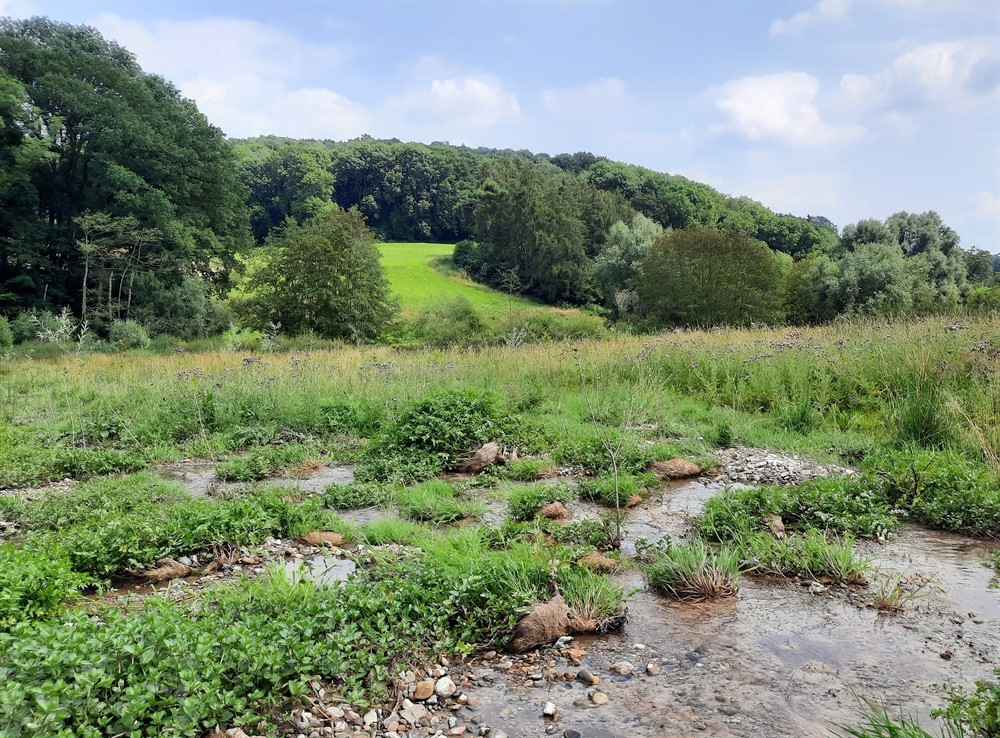Gulp valley natural climate buffer
Between 2018 and mid-2022, ARK Nature and Staatsbosbeheer will be collaborating with Belgian nature organisations on a project entitled “Gulp valley beyond borders, natural safety”. This project is aimed at climate-proofing the Gulp valley. The organisations intend to implement natural measures to retain rainwater in the area, in the purview of reducing the probability of waterlogging during extreme downpours and preventing damage in periods of drought.

What has prompted the creation of this climate buffer?
This project was triggered by the major flooding of the river Gulp in 2012. Torrential rain temporarily turned the brooklet into a raging stream. Several dry valleys in the Gulp valley turned into fast-running brooks that discharged additional water and mud into the river Gulp. This caused considerable damage in the village of Slenaken. To resolve this flood risk, the authorities initially considered constructing a dam in the Gulp valley. However, a dam would not quite fit into the Limburg landscape. This project demonstrates that waterlogging can also be combated through natural measures in the entire Gulp valley.
What measures are being taken?
To slow water run-off from the slopes and reduce mud transport to the valleys, ARK Nature, Staatsbosbeheer, and the Belgian nature organisations are implementing the following model measures in the Gulp valley:
- They are purchasing land on the steepest slopes in the Walloon provinces of Belgium. Small-scale grazing of cattle will turn the area into a rugged, natural grassland covered in shrubs. Such a landscape can slow down rainwater run-off;
- The organisations are converting farmland into grassland in order to combat mud flows;
- Steep slopes are planted with shrubs and woodland that absorb large volumes of water and are capable of slowing down water flows;
- Farmland that has been converted into natural grassland often contains old water outlets. Removal of such outlets will improve water retention;
- At several locations, more room will be created for the Gulp brook itself by lowering the banks, thus enabling the brook to safely store more water. This measure is referred to as “flowing storage”;
- Low-lying locations are being dug that provide landscape relief. These low-lying locations can temporarily collect water run-off from farmland areas. They also combat erosion;
- The organisations are providing information to schools in order to raise climate awareness among children. For example, they explain how to prepare for the impact of climate change by adapting and diversifying the landscape. They are also conducting tours for local residents and government authorities to show how natural measures can address several taskings at the same time.
How do the measures foster biodiversity?
These measures are improving the habitats of multiple wildlife species. By reducing mud flows, the brook is becoming cleaner, which is conducive to the Atlantic Salmon and the River Trout. The Black Stork is also returning to the Gulp valley, as it now comprises more woodland and wet grassland. Natural grassland covered in shrubs also benefits the Redbacked Shrike and the Hazel Dormouse.
Which parties are involved in this climate buffer?
For this project, ARK Nature and Staatsbosbeheer have joined forces with Belgian nature organisations Natagora and Regionaal Landschap Haspengouw en Voeren. ARK Nature has received an additional grant from Dutch charity lottery Nationale Postcode Loterij.
Contact person
Hettie Meertens
06-20449351
hettie.meertens@ark.eu
